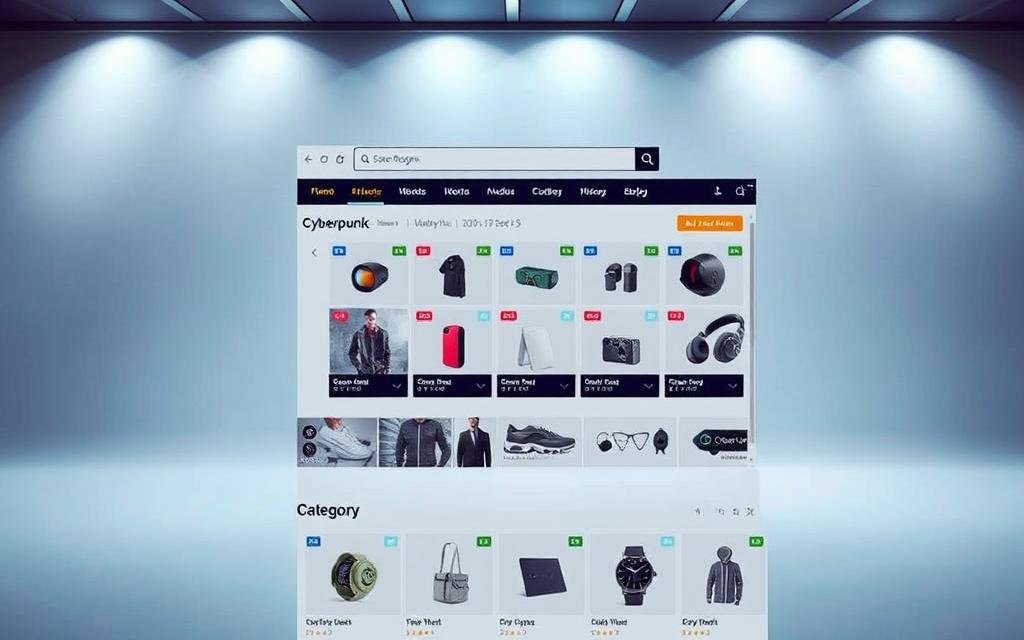In today’s competitive digital marketplace, optimizing your online store for search engines is crucial for standing out and driving sales. With retail e-commerce sales estimated to exceed $4.3 trillion worldwide by 2025, the importance of a well-planned SEO strategy cannot be overstated.
Unlike paid advertising, which stops generating traffic when you stop paying, effective SEO provides sustainable traffic and continues to attract potential customers over time. By optimizing your site’s content and structure, you can improve visibility in search results, drive more qualified traffic, and increase conversion rates.
Key Takeaways
- Understand the importance of E-Commerce SEO in a competitive digital marketplace.
- Learn how to optimize your online store for search engines.
- Discover the benefits of a well-planned SEO strategy.
- Find out how to drive sustainable traffic to your site.
- Improve your store’s visibility and conversion rates.
Understanding E-Commerce SEO
Understanding e-commerce SEO is key to increasing sales through search engines. In today’s digital landscape, having an online store is not enough; you need to ensure that your site is visible to potential customers. This is where e-commerce SEO comes into play.
What Is E-Commerce SEO?
E-commerce SEO refers to the process of optimizing your online store to rank higher in search engine results pages (SERPs). This involves making your site more search engine-friendly, improving content quality, and ensuring that your products are easily discoverable by search engines like Google. A well-optimized store makes products easier to discover, builds trust, and reduces reliance on paid traffic.

Why SEO Matters for Online Stores
SEO matters for online stores because it provides a cost-effective way to stand out among millions of competitors. Unlike paid advertising, which stops working when you stop paying, SEO creates lasting value that continues to drive organic traffic long after the initial optimization work is complete. Here are some key reasons why SEO is crucial:
- In the increasingly competitive e-commerce landscape, SEO helps you stand out.
- SEO creates lasting value that drives organic traffic over time.
- Search engines are often the first place customers turn when looking to make a purchase.
- A well-optimized store builds credibility and trust with both search engines and potential customers.
- E-commerce SEO helps you target customers at different stages of the buying journey.
By focusing on SEO, online stores can improve their visibility, drive more traffic, and ultimately increase sales.
The Business Impact of Effective SEO
SEO plays a pivotal role in the success of e-commerce businesses by enhancing their online visibility and credibility. A well-implemented SEO strategy can significantly influence an online store’s ability to attract and retain customers.
Sustainable Traffic vs. Paid Advertising
Relying on paid advertising alone can be costly and unsustainable in the long term. In contrast, effective SEO helps build sustainable traffic to your site, reducing reliance on paid ads. By optimizing your site and content for search engines, you can attract relevant traffic that is more likely to convert into sales.
A key benefit of SEO is its ability to provide long-term results without the ongoing costs associated with paid advertising. As your site ranks higher in search results, you’ll enjoy increased visibility and credibility, driving more qualified leads to your site.
Building Brand Authority Through Search
Consistently ranking well in search results establishes your brand as an authority in your niche. This authority builds trust with potential customers before they even visit your site. When your store appears at the top of Google search results for industry-specific keywords, it signals to customers that your business is established and trustworthy.
| SEO Benefits | Impact on Business |
|---|---|
| Increased Search Visibility | Drives qualified traffic to the site |
| Improved Brand Credibility | Establishes authority in the niche |
| Sustainable Traffic | Reduces reliance on paid advertising |
Keyword Research for E-Commerce Success
In the competitive world of e-commerce, keyword research is not just beneficial, it’s essential. Understanding what your potential customers are searching for and how they search for it can make or break your online store’s visibility and sales.
Effective keyword research involves more than just identifying popular search terms; it’s about finding the right balance between search volume, competition, and relevance to your products or services.
Finding High-Value Product Keywords
To identify high-value product keywords, you need to understand your target audience and analyze your competitors. Tools like Ahrefs can help you discover what keywords your competitors are ranking for, giving you insights into potential opportunities.
For example, if you compete with BustedTees, a geeky t-shirt e-commerce store, you can enter its domain into a keyword research tool and analyze the organic keywords it ranks for. This can help you decide where to compete for keywords.
| Keyword | Search Volume | Competition Level |
|---|---|---|
| Geeky T-Shirts | 2,900 | High |
| Funny T-Shirts | 1,300 | Medium |
| Nerd T-Shirts | 820 | Low |
Understanding Search Intent for Online Shoppers
Understanding search intent is crucial for e-commerce SEO. It’s not just about what shoppers are searching for, but why they’re searching for it. Are they looking for information, or are they ready to buy?
By understanding the intent behind search queries, you can tailor your content and product offerings to meet the needs of your customers, improving their shopping experience and increasing the likelihood of conversion.

Tools for E-Commerce Keyword Research
Several specialized tools can streamline your e-commerce keyword research process. Some of the most effective include:
- Google Keyword Planner: Provides search volume data and competition levels.
- Ahrefs and Semrush: Allow you to analyze competitor websites and discover potential keywords.
- Amazon’s autocomplete function and Keyword Tool Dominator: Help you find product-specific keywords.
- Moz Local and BrightLocal: Useful for identifying location-specific keywords for local e-commerce businesses.
By leveraging these tools and techniques, you can enhance your e-commerce SEO strategy, drive more targeted traffic to your site, and ultimately increase sales.
Creating an SEO-Friendly Site Architecture
A well-structured site architecture is crucial for e-commerce SEO success. It not only helps search engines understand and crawl your site more efficiently but also improves the user experience.
The Golden Rules of E-Commerce Site Structure
To create an effective site structure, follow these key principles. First, organize your category and product pages in a logical hierarchy that mirrors how customers naturally search for and browse your products.
- Implement breadcrumb navigation to help users understand their location within your site.
- Create clean, descriptive URLs that include relevant keywords.
- Ensure important category and product pages are accessible from your main navigation.
Category and Product Page Organization
Category pages should target broader keywords, while product pages should target specific, long-tail keywords. For example, a category page might target “men’s running shoes,” while a product page targets “Nike Air Zoom Pegasus38 men’s running shoe.”
| Page Type | Keyword Target | Example |
|---|---|---|
| Category Page | Broader Keywords | Men’s Running Shoes |
| Product Page | Long-Tail Keywords | Nike Air Zoom Pegasus38 Men’s Running Shoe |
Let’s take a look at a real-life example of an e-commerce site with awesome architecture: PetSmart.com. If you want to get a new dog food bowl for Fluffy, you’d head to the homepage, click “Dog,” then “Bowls & Feeders,” and get a list of products in that subcategory. Within three clicks, you’ve found what you want. And because PetSmart uses a flat site structure, Google will fully index all of their pages.

Technical SEO Fundamentals for Online Stores
As an online store owner, understanding and implementing technical SEO is vital for staying ahead of the competition and achieving long-term success. Technical SEO encompasses various behind-the-scenes elements that impact your website’s performance in search engines.
There are several key areas to focus on when it comes to technical SEO for e-commerce sites. These include site speed optimization, mobile optimization, and secure connections with SSL.
Site Speed Optimization
Site speed is a critical factor in both user experience and search engine rankings. A slow-loading website can lead to higher bounce rates and lower conversion rates. To optimize site speed, consider leveraging browser caching, compressing images, and minifying CSS and JavaScript files.
| Optimization Technique | Description | Impact on Site Speed |
|---|---|---|
| Browser Caching | Stores frequently-used resources locally | Reduces load time for repeat visitors |
| Image Compression | Reduces the file size of images | Decreases page load time |
| Minifying CSS and JavaScript | Removes unnecessary code | Reduces file size, improving load times |
Mobile Optimization and Responsiveness
With the majority of online shoppers using mobile devices, having a mobile-friendly website is no longer optional. Ensure that your e-commerce site is responsive and provides a seamless user experience across various devices and screen sizes.
Google recommends a mobile-first design approach, as it prioritizes the mobile version of your site for indexing and ranking purposes.
Secure Connections with SSL
Long gone are the days when having an SSL certificate for your site was optional. When you are selling something and/or collecting customer data in any way, you need to do so in a secure environment. Google has confirmed that HTTPS is a ranking factor, giving secure sites a slight advantage in search results.
- SSL certificates are essential for e-commerce sites, ensuring security, customer trust, and better search engine rankings.
- Google’s emphasis on HTTPS as a ranking factor means that secure sites have a competitive edge.
- Beyond SEO benefits, SSL encryption protects sensitive customer data, maintaining trust and complying with privacy regulations.

By focusing on these technical SEO fundamentals, online store owners can improve their website’s visibility, drive more traffic, and ultimately increase sales.
Mastering URL Structure and Crawlability
To enhance your online store’s visibility, mastering URL structure and crawlability is key. A well-organized URL structure helps search engines understand your site’s hierarchy, making it easier for them to crawl and index your pages.
Creating SEO-Friendly URLs
SEO-friendly URLs are crucial for improving your site’s search engine ranking. They should be descriptive, concise, and rich in keywords. Avoid using unnecessary characters or numbers that don’t add value to the URL. Instead, opt for a clean and straightforward structure that reflects the content of the page.
For instance, a URL like example.com/mens-shoes is more SEO-friendly than example.com/cat=1234. This not only helps search engines but also improves user experience, as users can understand what to expect from the page.
| URL Characteristics | SEO-Friendly | Not SEO-Friendly |
|---|---|---|
| Descriptiveness | example.com/mens-shoes | example.com/cat=1234 |
| Conciseness | example.com/products/shoes | example.com/products/category/subcategory/shoes |
| Keyword Richness | example.com/best-mens-running-shoes | example.com/shoes123 |
Managing Indexation with Robots.txt and Sitemaps
Managing how search engines index your site’s pages is vital for SEO. Your robots.txt file and XML sitemaps play critical roles in this process. Use robots.txt to guide search engines away from pages that shouldn’t be indexed, such as admin areas or duplicate content created by faceted navigation.
On the other hand, XML sitemaps help search engines discover and prioritize your most valuable pages. Ensure your sitemap lists all important URLs, organized by content type (products, categories, blog posts), and submit it to Google Search Console and Bing Webmaster Tools.
- Use robots.txt to block unnecessary pages.
- Create comprehensive XML sitemaps for essential pages.
- Submit sitemaps to major search engines.
- Regularly audit indexed pages for issues.

On-Page SEO for Product Pages
Product pages are the backbone of any e-commerce site, and optimizing them for SEO is vital. A well-optimized product page can significantly improve your site’s visibility, driving more traffic and potentially increasing sales.
Crafting Compelling Product Titles
The product title is one of the most critical elements of on-page SEO. It should be descriptive, including the product name and relevant keywords that customers might use when searching for the product. Avoid keyword stuffing; instead, focus on creating a title that is both informative and appealing to potential customers.
Writing Unique Product Descriptions
Unique and compelling product descriptions not only help with SEO but also enhance the user experience. Use detailed descriptions to tell the story of your product, highlighting its features and benefits. Ensure that each product description is unique and not duplicated across different products or copied from the manufacturer.
Optimizing Product Images
Excellent product images are another great way to set yourself apart from your competitors. To optimize product images, consider the following strategies:
- Compress images to reduce file size without sacrificing quality, as large images significantly impact page load times.
- Use descriptive, keyword-rich file names for all product images (e.g., “nike-pegasus-38-mens-running-shoe-blue.jpg” instead of “IMG12345.jpg”).
- Write detailed alt text for each image that describes the product accurately while naturally incorporating relevant keywords to improve accessibility and SEO.

By implementing these strategies, you can improve your product page’s visibility, enhance the user experience, and drive more sales.
Category Page Optimization Strategies
To enhance both the visibility and usability of an e-commerce site, category page optimization is key. Category pages are crucial as they help users navigate through the site and find relevant products, while also providing an opportunity for search engines to index a structured list of products.
Targeting Broader Keywords on Category Pages
Category pages offer a chance to target broader keywords that are relevant to a range of products. By doing so, e-commerce sites can attract a wider audience who are searching for categories of products rather than specific items. Effective keyword research is essential here to identify the most relevant and high-traffic keywords.
Balancing User Experience with SEO
While optimizing for search engines, it’s equally important to ensure that category pages provide a seamless user experience. This involves designing intuitive navigation, using faceted search to help users filter products, and ensuring that the page loads quickly. A well-designed category page should balance the needs of both search engines and human visitors.
Some key strategies for optimizing category pages include:
- Designing category pages that are intuitive for users and crawlable by search engines.
- Implementing faceted navigation to help users filter products, while avoiding duplicate content issues.
- Balancing keyword-rich content with a clean and uncluttered design.
- Monitoring user behavior metrics like bounce rate and time on page to indirectly improve search rankings.

By focusing on these strategies, e-commerce businesses can improve both the SEO and user experience of their category pages, ultimately driving more sales and growth.
Tackling the Duplicate Content Challenge
One of the most significant challenges e-commerce sites face in terms of SEO is managing duplicate content. Duplicate content can arise from various sources and can negatively impact a site’s search engine rankings if not addressed properly.
Common Sources of Duplicate Content
Duplicate content often occurs when product descriptions are provided by manufacturers and used across multiple websites. This makes it challenging for search engines to determine the original source of the content. Additionally, product variations, such as different colors or sizes of the same product, can also lead to duplicate content issues if not managed correctly.
Faceted navigation is another common source of duplicate content. When users can filter products by various attributes like price, brand, or color, it can create multiple versions of the same page, potentially diluting the ranking signals.

Using Canonical Tags Effectively
Canonical tags are a crucial tool in managing duplicate content. They are HTML elements that tell search engines which version of a page should be considered the “master” copy. By implementing canonical tags on all duplicate or similar pages, you can consolidate ranking signals to your preferred URL, strengthening its position in search results.
- For product variations, canonicalize to the main product page unless each variation has substantial unique content.
- When using faceted navigation, add canonical tags to filtered results pages pointing to the main category page.
- Regularly audit your canonical implementation to ensure tags are correctly formatted and pointing to accessible pages.
By effectively using canonical tags, e-commerce sites can mitigate the issues caused by duplicate content and improve their SEO performance.
Leveraging Structured Data for Rich Results
Structured data is a game-changer for e-commerce SEO, offering a way to stand out in search results. By providing search engines with additional context about your products and business, you can enhance your website’s visibility and potentially increase click-through rates.
One of the key benefits of structured data is its ability to provide rich results, which can make your listings more appealing to potential customers. To achieve this, it’s essential to understand the different types of structured data that can be implemented on an e-commerce site.
Product Schema Markup Essentials
Product schema markup is a critical component of e-commerce structured data. It provides detailed information about your products, such as price, availability, and reviews. By implementing product schema, you can help search engines understand your product offerings and potentially display rich snippets in search results.
For instance, using schema markup for product reviews can lead to star ratings appearing in search results, making your listing more attractive to potential customers. It’s crucial to ensure that the information provided in your schema markup is accurate and up-to-date to avoid any discrepancies.
Business Information Structured Data
In addition to product schema, business information structured data can also be beneficial for e-commerce sites. This type of schema provides details about your business, such as name, logo, contact information, and business hours. By implementing Organization schema or LocalBusiness schema, you can help search engines verify your business identity and improve your online presence.
Consistency is key when it comes to business information structured data. Ensure that the information on your website matches your Google Business Profile to build trust with search engines and avoid conflicting signals.
| Schema Type | Purpose | Key Information |
|---|---|---|
| Product Schema | Provides detailed product information | Price, availability, reviews |
| Organization Schema | Provides business information | Name, logo, contact details |
| LocalBusiness Schema | Enhances local search visibility | Address, phone number, business hours |
By leveraging structured data effectively, e-commerce businesses can improve their search engine rankings and provide a better user experience. As search engines continue to evolve, staying ahead of the curve with structured data implementation can be a significant competitive advantage.

Content Marketing for E-Commerce SEO
By leveraging content marketing, e-commerce businesses can create a robust SEO strategy that attracts and retains customers. Effective content marketing goes beyond merely producing content; it’s about crafting a strategic approach that resonates with your target audience and guides them through the buying process.
A key component of this strategy is developing a blog that complements your e-commerce site. This is where you’ll publish informative, engaging content that addresses the needs and concerns of your potential customers.
Creating a Strategic Blog for Your Store
To create a successful blog, you need to focus on producing high-quality, keyword-optimized content that speaks to your audience. This involves:
- Developing buying guides that compare products in your catalog, highlighting key features and benefits.
- Creating how-to content that demonstrates your products in action, solving real problems for your target audience.
- Incorporating customer testimonials, case studies, and user-generated content to provide social proof.
As
“Content is king”
is a well-known phrase in digital marketing, emphasizing the importance of quality content in attracting and engaging your audience.
Developing Content That Converts
Conversion-focused content is designed to strategically guide visitors toward making a purchase through targeted messaging and clear calls to action. To achieve this, you should:
- Implement a content mapping strategy that aligns specific content pieces with different stages of the customer journey.
- Use relevant keywords naturally within your content to enhance its visibility in search engine results.
By adopting these strategies, e-commerce businesses can enhance their SEO efforts, drive more qualified traffic to their site, and ultimately increase sales.
Building Quality Backlinks for Online Stores
Building quality backlinks is a crucial aspect of any e-commerce SEO strategy. It involves obtaining links from other reputable websites to your online store, which can significantly improve your site’s visibility and credibility in search engine results.
Partnership Strategies for Link Building
Forming strategic partnerships with other businesses or influencers in your niche can be an effective link building strategy. These partnerships can lead to opportunities for guest posting, product collaborations, or even simple mentions in their content, all of which can result in valuable backlinks to your site.
To maximize the effectiveness of these partnerships, focus on collaborating with entities that have a strong online presence and are relevant to your target audience. This not only enhances your backlink profile but also expands your reach to potential customers.
Guest Posting and Press Mentions
Guest posting on reputable industry blogs and publications is another effective way to earn quality backlinks. It’s essential to create high-quality, engaging content that adds value to the host site’s audience. This approach not only helps in acquiring backlinks but also establishes your brand as an authority in your niche.
Additionally, leveraging press mentions can significantly boost your backlink profile. Services like HARO (Help A Reporter Out) can connect you with journalists looking for expert insights, potentially leading to mentions in high-authority news sites. Creating newsworthy content, such as original research or industry surveys, can also attract the attention of journalists and bloggers, encouraging them to link back to your site.
Internal Linking Best Practices
Internal links play a vital role in enhancing the navigability and search engine ranking of your e-commerce website. By strategically linking to other relevant pages on your site, you can improve both the user experience and search engine optimization (SEO).
Strategic Navigation Design
A well-designed internal linking structure helps customers find what they’re looking for while also facilitating search engine crawlers to discover and index your content. To achieve this, consider implementing the following strategies:
- Use “related products” or “customers also viewed” sections to create natural internal linking opportunities.
- Employ descriptive, keyword-rich anchor text for internal links rather than generic phrases.
Cross-Selling Through Internal Links
Internal linking can also be used to cross-sell products and enhance the average order value. For instance, you can link to complementary items within product descriptions or create comparison guides that link to multiple products within a category.
| Internal Linking Strategy | Benefits |
|---|---|
| Related Products Sections | Enhances user experience, increases average order value |
| Descriptive Anchor Text | Improves SEO, clarifies link context |
| Comparison Guides | Facilitates purchasing decisions, strengthens internal link structure |
User Experience and Conversion Optimization
Enhancing user experience is crucial for e-commerce sites to boost conversion rates and foster brand loyalty. A well-designed site that caters to the needs of its customers can significantly improve sales and customer retention.
The SEO-UX Connection
The connection between SEO and user experience (UX) is more intertwined than ever. SEO strategies that focus on improving UX can lead to better search engine rankings. This is because search engines like Google prioritize sites that offer a good user experience. By optimizing your site’s structure, content, and overall usability, you can improve both your SEO and UX.
Elements such as page load speed, mobile responsiveness, and intuitive navigation play a crucial role in determining the user experience of your site. Ensuring these elements are optimized can lead to a more satisfying experience for your customers.
Reducing Friction in the Buying Process
To enhance the user experience and increase conversion rates, it’s essential to identify and eliminate friction points in the buying process. Here are some strategies to achieve this:
- Implement guest checkout options to reduce cart abandonment rates by up to 45%.
- Optimize your site search functionality to help customers quickly find what they’re looking for.
- Simplify your checkout process by minimizing form fields and providing multiple payment options.
- Use clear, action-oriented call-to-action buttons that stand out visually.
By implementing these strategies, you can create a smoother, more intuitive shopping experience that encourages customers to complete their purchases and return to your store.
Measuring E-Commerce SEO Success
Measuring the success of your e-commerce SEO strategy is vital for understanding its impact on your online store. To determine whether your efforts are paying off, you need to track the right metrics and use the appropriate tools.
Key Performance Indicators to Track
To evaluate the effectiveness of your e-commerce SEO, focus on key performance indicators (KPIs) such as organic traffic, search engine rankings, and conversion rates. Monitoring these metrics will help you understand how your SEO efforts are influencing your store’s visibility and sales.
Some essential KPIs to track include:
- Organic traffic growth
- Average search engine rankings for target keywords
- Conversion rates from organic traffic
- Revenue generated from organic search
| KPI | Description | Importance |
|---|---|---|
| Organic Traffic Growth | Increase in visitors from search engines | High |
| Average Search Engine Rankings | Position of your site in search results | Medium |
| Conversion Rates | Percentage of visitors who make a purchase | High |
Tools for Monitoring SEO Performance
Several tools can help you monitor and analyze your e-commerce SEO performance. These include:
- Google Search Console: Provides data on search engine visibility, clicks, and impressions.
- Google Analytics: Offers insights into user behavior and conversion paths.
- Paid SEO tools like Semrush, Ahrefs, or Moz: Provide comprehensive keyword tracking and competitor analysis.
- Specialized e-commerce analytics platforms: Help connect SEO performance to revenue metrics.
By leveraging these tools and tracking the right KPIs, you can gain a deeper understanding of your e-commerce SEO performance and make data-driven decisions to improve your online store’s visibility and sales.
Conclusion: Building a Sustainable SEO Strategy
A successful e-commerce SEO strategy requires a multifaceted approach that addresses technical foundations, content quality, and user experience simultaneously. To achieve this, focus on creating genuine value for your customers through informative content, intuitive navigation, and high-quality product offerings.
E-commerce SEO is an ongoing process, not a one-time project. Search algorithms evolve, competitors adapt, and customer expectations change over time. Therefore, it’s essential to prioritize your SEO efforts based on potential impact, starting with critical technical issues, then optimizing your most valuable product and category pages, and finally expanding to broader content marketing initiatives.
To maximize your online visibility, maintain a testing mindset and regularly experiment with different approaches to product descriptions, category organization, and content formats. Remember, the ultimate goal of e-commerce SEO isn’t just ranking well in search results, but converting visitors into satisfied customers who return and recommend your store to others.
By adopting a balanced and ongoing SEO strategy, you can drive sustainable growth for your e-commerce site and stay ahead in the competitive digital landscape.
